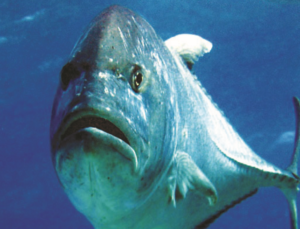REGION AND HABITAT – Giant trevally populations are widespread across the tropical and subtropical waters of the Indian and Pacific Oceans: from the east coast of Africa to the coastlines of India and Pakistan, the archipelagos of Southeast Asia, Oceania, and further west towards the Polynesian islands. Giant trevally thrive in a variety of marine habitats, most commonly in shallow coastal environments, but also in the brackish waters of estuaries and connecting rivers.

Intense geological activity precipitated the maliputo’s adaptation into a freshwater fish. The 18th century witnessed Taal Volcano’s most catastrophic eruption on record: a surviving narrative account of a Father Buencuchillo, parish priest of Sala, documented a six month eruption that lasted from May 15 to December 1, 1754. Volcanic debris and pyroclastic material emitted by Taal Volcano blocked the Pansipit River, cutting off Taal Lake from Balayan Bay and submerging lakeside towns already devastated by the eruption. Monsoon rains from that same year hastened its desalination, filling the lake with ten meters of rainfall. The lake is also home to the tawilis (freshwater sardine) and Hydrophis semperi, one of the two known freshwater sea-snakes in the world, in addition to cultivated fish populations.
Taal Lake, Volcano Island, and surrounding municipalities comprise the Taal Volcano Protected Landscape: one of the Key Biodiversity Areas of the Philippines, as identified by National Biodiversity Conservation Priority Setting Project jointly undertaken by the Department of Energy and Natural Resources-Protected Areas and Wildlife Bureau, UP Center for Integrative and Development Studies, and Conservation International-Philippines.

CHARACTERISTICS AND BEHAVIOR – Maliputo may be indigenous to Taal Lake (and its only distributary, the Pansipit River), but the more common saltwater variant can also be found in Pagbilao Bay, the Calamianes Islands in Palawan, Davao Gulf, the Sulu-Celebes Sea, and the Spratly Islands.
The local name of the saltwater giant trevally is familiar to most: talakitok, an adage shared with other members of the Carangidae family―many of which can be found all over the archipelago―and which share the maliputo’s steep and blunt head profile, ovate-shaped and moderately compressed body, and the silver-gray color found in smaller specimens of giant trevally.
The giant trevally is the largest member of the Caranx genus, with specimens recorded at 170 centimeters (cm) and 80 kilograms (kg). These supersized fish are a rare occurrence, though; Fish-base notes that specimens average at 60 cm. Juveniles and subadults tend to live in waters with low salinity such as estuaries, shallow bays, and lagoons, while adult specimens are commonly associated with deeper reefs and offshore atolls.
Adult giant trevally have been observed to be solitary creatures that primarily school for spawning. Or, on the rare occasion, for hunting: it is classified as a predatory fish, and uses considerable strength to stun and strike its prey. Its eye anatomical adaptations may also be an evolutionary adaption for hunting: the horizontal streak in its eye―with its significantly greater ganglion and photo-receptor cell densities―is believed to allow panoramic vision, making it easier for the giant trevally to better detect its prey. Its upper jaw has two layers of teeth―strong outer canines and a smaller, inner band―while its lower jaw has one layer of conical teeth. The giant trevally’s diet is dependent on its native habitat, but consist mostly of smaller fish, crustaceans, or mollusks; larger specimens have even been known to take on juvenile turtles and dolphins.

The maliputo is a catadromous fish: it breeds and spawns in estuarine waters and, upon maturity―the fish grows up to three kilos―migrates upstream seeking freshwater. Maliputo spawn in Balayan Bay and migrate to the Taal Lake via the Pansipit River. Spawning season varies with each location, generally occurring during warmer months; in the Philippines, however, spawning of the wild population has been observed to take place during December and January, with a lesser season occurring in June.
BREEDING IN CAPTIVITY – The communities surrounding Taal Lake have a history of depleting fish population: the native bull shark was wiped out in the 1930s due to over-fishing. Considered a local delicacy in the lakeshore towns, the once-abundant maliputo population has approached rare status, but in 2006, the Bureau of Fisheries and Aquatic Resources (BFAR) has devised a means to mitigating this problem, while addressing the need to sustain livelihood and achieve food security.
A team of aquaculturists led by Maria Theresa Mutia has developed a process for the inducement of natural spawning in mature maliputo; the fish were subjected to hormonal injections that induced spawning after 28 hours, with eggs hatching 16 hours later. Prior to this discovery, fishpond owners only relied on the capture of wild fingerlings for breeding.
BFAR’s continued refinement of maliputo aquaculture at the National Fisheries Biological Center has helped sustain the fish population and community livelihood following the Taal Lake fishkills of 2008 and 2011.
This story appeared in Animal Scene’s April 2015 issue.






